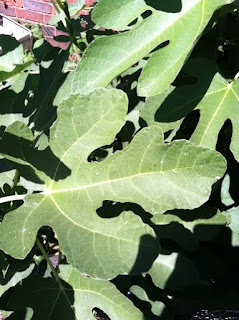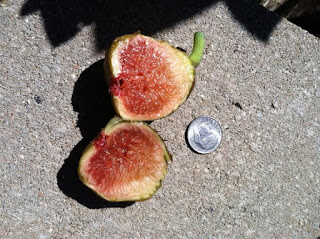Been doing some Fig rooting experiments with coarse sand in fabric pots and the results so far are really amazing! Fabric pots are all the rage these days, promoting healthier plants via more aeration in the root zone. I believe this to be true. Newly formed Fig roots are very sensitive and susceptible to rot from excessive moisture in too little aeration media.
The system we've been experimenting with is pretty much the same concept as any other wicking media in cloth pot type, except we're using only coarse sand as the media and a diluted hydroponic fertilizer, mixed in the water, referred to as "fertigation".
Our Fig subjects are cuttings that have been buried horizontally, within the top inch of four inches depth of the sand and the 2 gallon Root Pouch grow bags we purchased online are sitting in the "trays" we cut from square plastic pails. We try to keep approximately 1/2 inch of fertigation in the trays at all times and the sand wicks it upwards, into the root zone.
The fabric pots in the photo above are approx four inches diameter with four inches depth of sand. We wanted some smaller pots to experiment with some smaller, one and two node Fig cuttings.
It was observed in experiments that our particular grade of sand, referred to as 10-20 by the sand plant or "coarse builders sand", will wick fairly well up to three-four inches height. The fabric itself also wicks a bit so our sand stays moist enough for rooting of Fig cuttings and allows enough oxygen in the rooting zone, without being too overly wet, that will result in rotting of the delicate new Fig roots.
We purchased a roll of this popular landscape fabric for about $20, tax included. It's 3' wide x 100' long and has a dark colored smooth side and a light colored, sort of fuzzy side.
We started by marking some lines to cut out our pieces. For this size of pot, we have measured 12" from the edge and made four 9"sections.
Here comes the no-sew part. Most all landscape fabric is some sort of woven plastic and will work with a food storage sealing machine. We have folded about 3/4 inch of the black side towards the light side and formed a seam for the top edge of the pots along a 12" side.
Next we fold it over and make a double seal seam for the side of the pot, trying to get close to the edge as possible. Practice helps with this.
Next we bunch up the bottom as best we can...
Install a small cable tie and trim off the end of it.
All there is left to do is turn the fabric bag inside out and fill with your media. They stand up just fine and are strong enough to hold wet sand, probably the heaviest media one would ever use in them.
That's pretty much all there is to it. Without any mistakes, we can get four-hundred of this size pot from one roll of landscape fabric at a cost of $.05 per bag for fabric, plus the cost of the cable tie, probably about $.01 each.
As an alternative to using cable ties to secure the bottom, simply make a double seal along the bottom and then turn the bag inside-out, leaving the corners tucked in a bit. It doesn't go as flat as using the tie but seems to add extra height and with sand it still will flatten enough to stand on its own.
The same 9" x 12" starting piece of fabric, sealed along the 12" side, makes a 2.5" diameter bag, 10.75" tall. This is for those folks who can't fathom the act of completely burying their cuttings under the surface. :)
Here are some recent Fig photo's of the wicking sand grow bags experiment...
The Valley Black Fig above was started in a previous sand experiment in a plastic pail (below), separated into three plants and each transferred into the Root Pouch grow bags with sand, where they are currently thriving, growing like crazy!.
















































